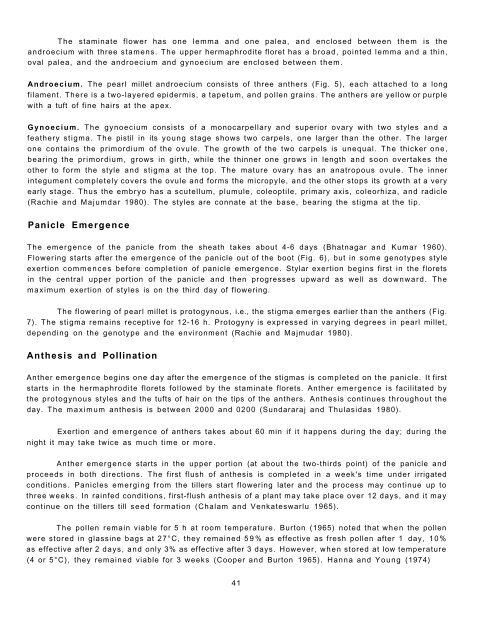Training Manual Development Of Cultivars And Seed ... - icrisat
Training Manual Development Of Cultivars And Seed ... - icrisat
Training Manual Development Of Cultivars And Seed ... - icrisat
You also want an ePaper? Increase the reach of your titles
YUMPU automatically turns print PDFs into web optimized ePapers that Google loves.
The staminate flower has one lemma and one palea, and enclosed between them is the<br />
androecium with three stamens. The upper hermaphrodite floret has a broad, pointed lemma and a thin,<br />
oval palea, and the androecium and gynoecium are enclosed between them.<br />
<strong>And</strong>roecium. The pearl millet androecium consists of three anthers (Fig. 5), each attached to a long<br />
filament. There is a two-layered epidermis, a tapetum, and pollen grains. The anthers are yellow or purple<br />
with a tuft of fine hairs at the apex.<br />
Gynoecium. The gynoecium consists of a monocarpellary and superior ovary with two styles and a<br />
feathery stigma. The pistil in its young stage shows two carpels, one larger than the other. The larger<br />
one contains the primordium of the ovule. The growth of the two carpels is unequal. The thicker one,<br />
bearing the primordium, grows in girth, while the thinner one grows in length and soon overtakes the<br />
other to form the style and stigma at the top. The mature ovary has an anatropous ovule. The inner<br />
integument completely covers the ovule and forms the micropyle, and the other stops its growth at a very<br />
early stage. Thus the embryo has a scutellum, plumule, coleoptile, primary axis, coleorhiza, and radicle<br />
(Rachie and Majumdar 1980). The styles are connate at the base, bearing the stigma at the tip.<br />
Panicle Emergence<br />
The emergence of the panicle from the sheath takes about 4-6 days (Bhatnagar and Kumar 1960).<br />
Flowering starts after the emergence of the panicle out of the boot (Fig. 6), but in some genotypes style<br />
exertion commences before completion of panicle emergence. Stylar exertion begins first in the florets<br />
in the central upper portion of the panicle and then progresses upward as well as downward. The<br />
maximum exertion of styles is on the third day of flowering.<br />
The flowering of pearl millet is protogynous, i.e., the stigma emerges earlier than the anthers (Fig.<br />
7). The stigma remains receptive for 12-16 h. Protogyny is expressed in varying degrees in pearl millet,<br />
depending on the genotype and the environment (Rachie and Majmudar 1980).<br />
Anthesis and Pollination<br />
Anther emergence begins one day after the emergence of the stigmas is completed on the panicle. It first<br />
starts in the hermaphrodite florets followed by the staminate florets. Anther emergence is facilitated by<br />
the protogynous styles and the tufts of hair on the tips of the anthers. Anthesis continues throughout the<br />
day. The maximum anthesis is between 2000 and 0200 (Sundararaj and Thulasidas 1980).<br />
Exertion and emergence of anthers takes about 60 min if it happens during the day; during the<br />
night it may take twice as much time or more.<br />
Anther emergence starts in the upper portion (at about the two-thirds point) of the panicle and<br />
proceeds in both directions. The first flush of anthesis is completed in a week's time under irrigated<br />
conditions. Panicles emerging from the tillers start flowering later and the process may continue up to<br />
three weeks. In rainfed conditions, first-flush anthesis of a plant may take place over 12 days, and it may<br />
continue on the tillers till seed formation (Chalam and Venkateswarlu 1965).<br />
The pollen remain viable for 5 h at room temperature. Burton (1965) noted that when the pollen<br />
were stored in glassine bags at 27°C, they remained 5 9 % as effective as fresh pollen after 1 day, 10%<br />
as effective after 2 days, and only 3% as effective after 3 days. However, when stored at low temperature<br />
(4 or 5°C), they remained viable for 3 weeks (Cooper and Burton 1965). Hanna and Young (1974)<br />
41

















